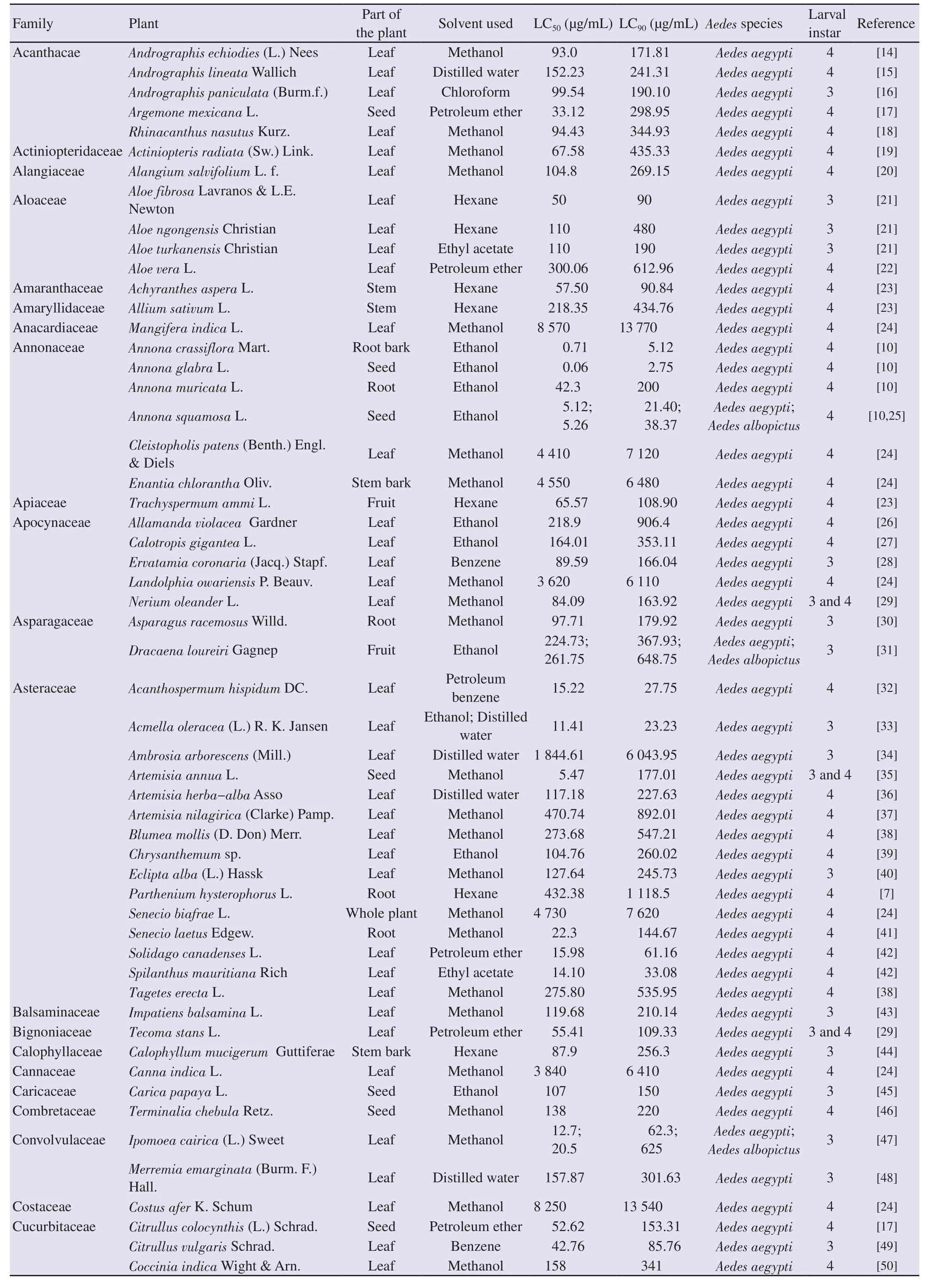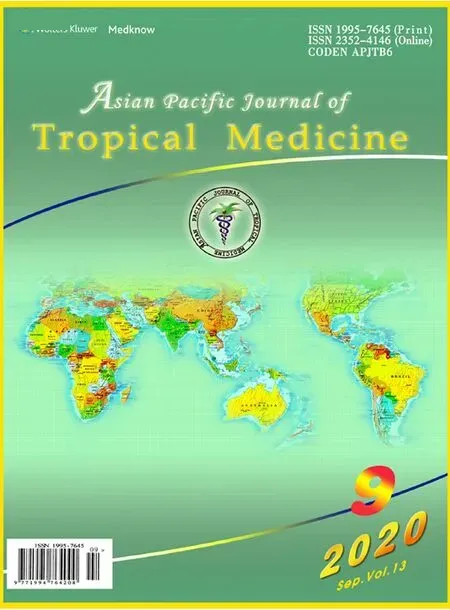Larvicidal efficacy of plant extracts and isolated compounds from Annonaceae and Piperaceae against Aedes aegypti and Aedes albopictus
2020-09-04AlzeirRodriguesVictorEmanuelMartinsSeleneMorais
Alzeir M.Rodrigues, Victor Emanuel P.Martins, Selene M.Morais
1Departamento de Ensino, Instituto Federal de Educação, Ciência e Tecnologia do Ceará (IFCE), Rodovia CE 060, km 332, Vila Martins, 63.560-000 Acopiara, Ceará, Brazil
2Programa de Pós-Graduação em Biotecnologia, RENORBIO, Universidade Estadual do Ceará, Avenida Doutor Silas Munguba, 1700, 60741-000 Fortaleza, Ceará, Brazil
3Instituto de Ciências Exatas e da Natureza, Universidade da Integração Internacional da Lusofonia Afro-Brasileira (Unilab), Campus das Auroras,Rua José Franco de Oliveira s/n, 62790-970 Redenção, Ceará, Brasil
4Departamento de Química, Universidade Estadual do Ceará, Avenida Doutor Silas Munguba, 1700, 60741-000 Fortaleza, Ceará, Brazil
ABSTRACT
KEYWORDS:Larvicidal activity; Plant extracts; Acetogenins;Aedes
1.Introduction
Dengue, chikungunya and Zika viruses are emerging arboviruses in tropical countries such as Brazil, being spread mainly by Aedes(Ae.) aegypti[1]and Ae.albopictus[2].Lately, the flow of people between continents has increased the transmission of these arboviruses, which has prompted numerous efforts to implement control strategies, given the lack of effective vaccines against their etiological agents[3].Thus, several strategies have been developed to control Ae.aegypti mosquitoes including mechanical controls such as elimination of breeding sites, reservoir drainage, and installation of screens on doors and windows; biological controls such as the use of fish and invertebrates that feed on immature stages of mosquitoes,the use of fungi and bacteria that produce lethal toxins to Aedes;and chemical controls such as the use of neurotoxic substances, and juvenile hormone analogs or chitin synthesis inhibitors to eliminate these vectors[4].
Plants have several bioactive compounds that are necessary for their survival against attacks by herbivorous pathogens and animals[5].Several substances are accumulated and used in defense;some of them containing volatile compounds (acids, aldehydes and terpenes), which are produced and released to attract pollinating agents as well as to defend against herbivores.Among the classes of substances of plant origin with proven larvicidal activity are amides,quinones, flavonoids, rotenoids, chromanones, prenylated stilbenes,phenylpropanoids, coumarins, alkylphenols, lignans, lactones,monoterpenes, sesquiterpenes, diterpenes, triterpenes, limonines,saponins, quassinoids and alkaloids[6].
Plant extracts are mixtures of secondary metabolites with wide applications such as bioinsecticides.They can be obtained from roots, stems, leaves, flowers, fruits and seeds using solvents with different polarities[7,8].
Substances obtained from many plants are used in folk medicine,due to active principles that provide benefits against various diseases and conditions.In this respect, plants of the Annonaceae family are widely used in traditional medicine for a range of human diseases,such as cancer and parasitic diseases[9].In particular, an acetogeninrich fraction and annonacin isolated from the ethanolic extract of Annona (A.) muricata L.were found to be active against Ae.aegypti and Ae.albopictus larvae[8].
Given the wide dispersion of Aedes mosquitoes and the consequent increase in the risk of transmission of pathogens carried by them,there is a need for alternative vector control measures to minimize the environmental impacts of substances such as synthetic insecticides.Therefore, it is necessary to identify the families of plants with the greatest potential for the control of vector mosquitoes and the isolated compounds that can serve as a basis for the synthesis of industrial larvicides.This study examines the larvicidal potential of plant extracts and compounds isolated from plants of the families Annonaceae and Piperaceae against Ae.aegypti and Ae.albopictus.
2.Methods and criteria for literature selection
We selected the articles with a focus on larvicidal activity against Ae.aegypti and Ae.albopictus of plant extracts and acetogenins isolated from plants of the Annonaceae family, available in the Web of Science database, using the following control descriptors:“plant extract”, “larvicidal activity”, “mosquito”, “Aedes”, “acetogenins”,“Annonaceae”, “Piperaceae” and “isolated”, with interposition of the Boolean operator “AND”, from 2000 to 2019 only for plant extracts, while search for articles on acetogenins had no period filter(accessed between January and July 2019).Therefore, all LC50(90)values are presented in µg/mL to allow comparison of results.In the case of studies investigating several extracts, with different solvents or parts, of the same plant species, we include the results with the smallest LC50.Articles with no data on LC50and LC90were excluded from the study (Figure 1).
3.Larvicidal effects of plant extracts
In this review, 97 complete articles were selected, as described in the selection methods shown in Figure 1.The larvicidal potential of plant extracts from 150 species distributed in 52 botanical families was evaluated on Ae.aegypti and Ae.albopictus, vectors of recurrent arboviruses in tropical and subtropical countries.Most of the plants whose extracts were tested are from the families Fabaceae(18 species), Asteraceae (15 species), Euphorbiaceae (10 species),Rutaceae (8 species), Cucurbitaceae (7 species), Lamiaceae (6 species)and Annonaceae (6 species).At the same time, almost all plant extracts(138 species) were tested only on Ae.aegypti species, while only 12 plants were tested against Ae.albopictus larvae (Table 1).

Figure 1.Flowchart with description of the design process of this study.

Table 1.Larvicidal activity of plant extracts on Aedes aegypti and Aedes albopictus larvae.

Table 1.Continued.

Table 1.Continued.

Table 2.Larvicidal activity of isolated Piperaceae compounds against Aedes aegypti.
Regarding the toxicity of the extracts of these plants on Aedes larvae, only 21 plants out of 150 investigated showed noteworthy larvicidal effect, with LC50values below 20 µg/mL.Among these plants, the Annonaceae family presented the best performance, in which 3 of the 6 studied species had LC50lower than 10 µg/mL(Table 1).A.glabra and A.crassiflora presented LC50values of 0.06µg/mL and 0.71 µg/mL, respectively[10].
Two of the Piperaceae families investigated, Piper (P.) longum L.and P.nigrum L., showed strong action, with LC50values of 0.248 µg/mL and 0.405 µg/mL, respectively, against Ae.aegypti larvae[11].According to Simas et al.[12], fractionation of P.nigrum ethanol extract, biomonitored by assays with pyrethroid-resistant Ae.aegypti larvae, yielded isolation of the larvicidal amides piperolein-A and piperine.With respect to LC50values, the ethanol extract of P.nigrum (0.405 µg/mL) (Table 1) was the most toxic,in comparison with the isolated compounds pipericine (25 µg/mL)and piperine (10 µg/mL) (Table 2).In tests with substances derived from P.longum, no activity was observed of piperettine, piperine, or piperlongumine[13].It seems that extracts are better larvicides than isolated constituents, probably due to the synergism among several constituents of the extract.
4.Annonaceae for vector control
Annonaceae is a family of plants widely adapted to rainforests, with 2 500 identified species distributed in 135 genera worldwide[101,102].In Brazil, there are 29 genera and 385 species in the Amazon and Atlantic rainforests, denoting richness and diversity.Anonaceae plants are economically important because their fruits are edible,eaten fresh and/or used in the production of juices and ice cream,such as ata (A.squamosa L.), graviola (A.muricata L.) and biribá (A.mucosa Jacq.)[103].
The potential for biological activities of substances derived from A.mucosa has been investigated and antimicrobial, larvicidal,insecticidal, repellent and antitumor activities have been confirmed[104-110].Acetogenins (ACGs) with antileishmanial properties[111]and larvicides[8]were obtained from A.muricata seeds.
In biosynthetic terms, ACGs are compounds derived from long fatty acid chains.In long aliphatic chains (between 32 and 34 carbon atoms) of ACGs, one, two or three tetrahydrofuran (THF)or tetrahydropyran rings can be found, plus a terminal, saturated or unsaturated γ-lactone ring[112].
A.squamosa seed extract showed adulticidal, larvicidal and ovicidal effects and deterred oviposition of Ae.albopictus[25].The ethanol extract of A.muricata and its major component, annonacin,had significant larvicidal action on Ae.aegypti and Ae.albopictus populations, through enzyme inhibitory effect[8].
The larvicidal activity of 50 acetogenins isolated from plants of the Annonaceae family on Aedes was investigated, and only the potential of annonacin was verified against Ae.albopictus.All other acetogenins were tested only on Ae.aegypti (Table 3).Among the acetogenins tested, 24 are classified as mono-THF because they have only one tetrahydrofuran ring, and 26 are bis-THF because they have two tetrahydrofuran rings[112](Table 3).Structural representations of acetogenins are available in supplementary Table 1.
Regarding the larvicidal potential of ACGs mono-THF, 9 out of 24 ACGs tested presented LC50values below 10 µg/mL, while LC50above 50 µg/mL.In the ACGs bis-THF, 19 out of 26 had LC50below 10 µg/mL and only 2 ACGs had LC50above 50 µg/mL (Table 3).Hence, there is a positive correlation between the number of THF rings and the larvicidal potential of ACGs.
Among the 14 most active ACGs on Ae.aegypti are:bullatacin(LC50=0.1 µg/mL), rolliniastatin-1 (LC100=0.2 µg/mL), trilobin(LC50=0.67 µg/mL), purpureacin-2 (LC50=1 µg/mL), asiminacin(LC50=1.6 µg/mL), sylvaticin (LC50=1.6 µg/mL), trilobacin(LC50=1.6 µg/mL), asimicin (LC50=1.7 µg/mL), cherimoline(LC100=2 µg/mL), purpureacin-1 (LC100=2 µg/mL), mucosin(LC50=2.1 µg/mL), muricatretrocin B (LC50=2.2 µg/mL),gigantetrocinone (LC50=2.2 µg/mL) and annonacin (LC50=2.65 µg/mL)(Table 3).

Table 3.Larvicidal action of acetogenins against Aedes aegypti and Aedes albopictus.
The ethanol extract of A.muricata root presented LC50of 42.3 µg/mL against Ae.aegypti[10]while isolated compounds had lower LC50values, such as annonacin, annonacin A, annonacin 4-OAc, with LC50values of 2.65, 10.80 and 6.20 µg/mL, respectively[8,113].
There is no doubt about the potential of natural products extracted from plants for the control of mosquito vectors of human diseases such as arboviruses.However, despite the vast literature confirming the larvicidal action of plant extracts and their isolated constituents,no commercial plant-based larvicide is available at this time[114].
5.Piperaceae for vector control
The Piperaceae family comprises 4 000 species of plants that are distributed in five genera:Manekia, Peperomia, Piper, Verhuellia and Zippelia.They are found in tropical countries and often used in traditional medicine.In Brazil, peppers such as P.cernuum (bat pepper) are used to control abdominal colic[119].The performance of natural Piperaceae products has been demonstrated on Ae.aegypti larvae[68]and their high lethality has been shown to be a promising source for the alternative control of these mosquitoes[11].
The larvicidal activity of 8 compounds isolated from plants of the genus Piper of the family Piperaceae were tested against Ae.aegypti larvae in the fourth instar and presented LC50below 32 µg/mL (Table 2).
6.Conclusions and perspectives
This review shows the abundance of research on the effect of natural products of plant origin on Aedes larvae, especially in relation to the species Ae.aegypti, the main vector of arboviruses such as dengue, Zika and chikungunya in Brazil.However, few studies have reported the effect of these plants against Ae.albopictus, a secondary vector of these diseases.
The two plant families whose extracts were most active on Aedes were found to be Annonaceae and Piperaceae, plants whose fruits are used for food and therefore grown for this purpose (e.g., A.muricata,A.mucosa, P.nigrum and P.longum).This suggests the possible economic feasibility of using these plants to produce commercial insecticides.Acetogenins, isolated from Annonaceae, have shown significant larvicidal activity, so further studies should be performed to verify the viability of these substances as commercial larvicides.The synthesis of acetogenins with high larvicidal activity is already known, such as annonacin, muricatetrocin and sylvatacin, among many others[120,121], all of which can be used for production of these compounds.
We believe it is economically feasible to produce environmentally safe natural larvicides with low lethality to non-target organisms from plant extracts of the Annonaceae or Piperaceae family,including through organic synthesis of the most active acetogenins,which are effective in controlling mosquito vectors of human diseases such as Ae.aegypti and Ae.albopictus.
Conflict of interest statement
The authors declare that they have no conflict of interest.
Authors' contributions
AMR and SMM designed the study.VEPM suggested that AMR investigate the larvicidal activity of plant extracts, while SMM suggested the introduction of the larvicidal action of acetogenins.All three authors discussed the manuscript.AMR and SMM led the writing of the manuscript with the support of VEPM.VEPM critically reviewed the approach regarding arboviruses and mosquito vectors.All authors discussed the results and contributed to comments on the manuscript.The whole manuscript was read and approved by all authors.
杂志排行
Asian Pacific Journal of Tropical Medicine的其它文章
- COVID-19 and zoonosis:Control strategy through One Health approach
- Lymphopenia as a marker for disease severity in COVID-19 patients:A metaanalysis
- Performance and correlation of QuantiFERON-TB Gold, T-SPOT.TB and tuberculin skin test in young children with or exposed to tuberculosis
- Morphometric analysis of sand fly (Diptera:Psychodidae:Phlebotominae),Sergentomyia anodontis Quate and Fairchild, 1961, populations in caves of southern Thailand
- Soil-transmitted helminth egg contamination from soil of indigenous communities in selected barangays in Tigaon, Camarines Sur, Philippines
- Knowledge of coronavirus disease 2019 (COVID-19) among healthcare providers:A cross-sectional study in Indonesia
